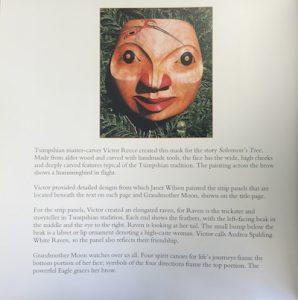Solomon’s Tree, written by Andrea Spalding and illustrated by Janet Wilson, is a picture book about a Tsimpshian boy named Solomon and his dear relationship with a Maple tree that grows in his yard.
The book paints a deeply mutual relationship between Solomon and the Maple tree, with various scenes depicting the conversations shared between Solomon and the tree; The tree seems to be a source of knowledge and mentoring for Solomon. In a tragic storm, the tree falls and leaves Solomon in devastation, but Solomon’s family uses the circumstance as an opportunity for growth. Solomon is encouraged by his parents to work with his uncle in order to carve a log of the Maple tree into a mask, transforming the living spirit of the tree into the living spirit of the mask.
I think that Solomon’s Tree is an excellent source of culturally-relevant teaching and I would assess high marks in applying the rubric for evaluating multicultural literature to the book. The plot itself is not necessarily complex, but in my opinion, that allows for students of non-Tsimpshian cultures to relate to the text. Also I think we must keep in mind that the book is written in reference to Solomon’s perspective, which gives a sense of authenticity. I especially appreciated the conclusive paragraph that showed the intentionality and efforts put in by the collaborated artists in the publishing of the book (For example, the strip panel formline designs).
in reference to Solomon’s perspective, which gives a sense of authenticity. I especially appreciated the conclusive paragraph that showed the intentionality and efforts put in by the collaborated artists in the publishing of the book (For example, the strip panel formline designs).
I think that any reader may be able to relate to how nature can be cyclical, and how nature requires gratitude, two of the major themes presented in the book. These themes can also be applied to various Social Studies lessons, learning about the different types of relationships that various cultures have had throughout time. Although there is a growth in the movement towards ecological justice, not all cultures have come to that conclusion nor have had any exposure in their histories. Think of the Catholic Bible, for example. On one hand, some people believe that Adam and Eve’s presence in the Garden of Eden implies that human beings have control over all the resources in the earth to our disposal. On the other hand, Liberation Theologians believe that God exists in all things, so it is our obligation as humans to respect and take care of nature.
I think that there is great value in utilizing picture books, especially children’s picture books, to share and spread messages. The emotional responses and triggers may provide space for great connections among the students and among various cultures.

I remember seeing this book and was curious about it, so thank you for sharing! Also, I always love reading your writing…I can hear your voice and it reads so easily and smooth 🙂
Chris- I really like your idea of using this book as an introduction to possible social studies lessons on environmental / ecological justice. I remember learning about things like climate change in science class and the Exxon Valdez in social studies… but I don’t really remember response to these issues being discussed as a form of activism. I never remember conversations about the destruction of the environment being connected to social justice issues. There are so many young people that are influential in the environmental justice movement right now that this seems like it could be particularly relevant to secondary students.
For instance this amazing story about Xiuhtezcatl Tonatiuh who is 15 and is suing the US government over the government’s negligence in addressing climate change. YouTube video here: https://www.youtube.com/watch?v=gXBR5ZrKdws
Or this story told by 17 year old Nelson Kanuk from Alaska who discusses how climate change has impacted his life and home. YouTube video here: https://www.youtube.com/watch?v=G1J3lp1snCo